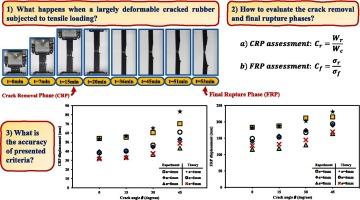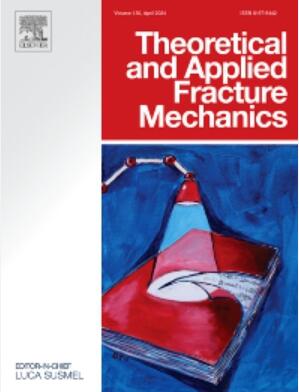突出裂纹消除现象的大变形超弹性材料混合模式断裂评估
IF 5
2区 工程技术
Q1 ENGINEERING, MECHANICAL
引用次数: 0
摘要
由于具有特殊的机械特性,橡胶如今被广泛应用于各行各业。本研究通过实验、数值和分析方法,研究了在混合模式(I/II)加载下,现有裂纹对填充有炭黑(CB)的丁腈橡胶(NBR)行为的影响。实验结果表明,在开裂的高变形性橡胶中,在最初的裂纹钝化之后,裂纹几乎被消除,试样的变形方式使得试样中几乎不存在应力集中因子的迹象。因此,这些橡胶的断裂分为两个独立的阶段,在此分别命名为裂纹消除阶段和最终断裂阶段,并为每个独立阶段制定了不同的标准,以评估开裂橡胶的断裂情况。基于每个标准的理论预测与相应的实验数据之间的良好一致性证实了所提出的标准非常准确。此外,还研究了临界 J 积分值 (Jc) 与模式混合度的独立性。本文章由计算机程序翻译,如有差异,请以英文原文为准。

Mixed-mode fracture assessment of largely deformable hyperelastic materials highlighting crack removal phenomenon
Due to the special mechanical characteristics, rubbers are nowadays utilized in various industries. In this research, the effect of an existing crack on the behavior of Nitrile Butadiene Rubber (NBR) filled with Carbon Black (CB), which has shown high deformability, is investigated experimentally, numerically and analytically under mixed-mode (I/II) loading. It is observed experimentally that in the cracked largely deformable rubbers, after the initial crack blunting, the crack is nearly removed and the specimen is deformed in such a way that almost no sign of stress concentration factor exists in the sample. Thus, the rupture of these rubbers is divided into two separate phases; named here as the crack removal phase and the final rupture phase, and for each separate phase, a distinct criterion is developed to assess the fracture of cracked rubbers. The good agreement between the theoretical predictions based on each criterion and the corresponding experimental data confirms the very good accuracy of the presented criteria. The independence of critical J-integral value () from the mode mixity is also investigated.
求助全文
通过发布文献求助,成功后即可免费获取论文全文。
去求助
来源期刊

Theoretical and Applied Fracture Mechanics
工程技术-工程:机械
CiteScore
8.40
自引率
18.90%
发文量
435
审稿时长
37 days
期刊介绍:
Theoretical and Applied Fracture Mechanics'' aims & scopes have been re-designed to cover both the theoretical, applied, and numerical aspects associated with those cracking related phenomena taking place, at a micro-, meso-, and macroscopic level, in materials/components/structures of any kind.
The journal aims to cover the cracking/mechanical behaviour of materials/components/structures in those situations involving both time-independent and time-dependent system of external forces/moments (such as, for instance, quasi-static, impulsive, impact, blasting, creep, contact, and fatigue loading). Since, under the above circumstances, the mechanical behaviour of cracked materials/components/structures is also affected by the environmental conditions, the journal would consider also those theoretical/experimental research works investigating the effect of external variables such as, for instance, the effect of corrosive environments as well as of high/low-temperature.
 求助内容:
求助内容: 应助结果提醒方式:
应助结果提醒方式:


